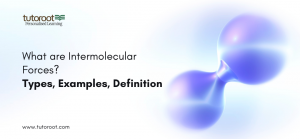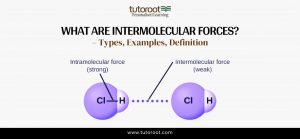What are Intermolecular Forces? – Types, Examples, Definition

Intermolecular forces are essential in influencing the physical characteristics of substances. They are the forces of attraction or repulsion between neighbouring particles (atoms, molecules, or ions) and are fundamental in understanding the behaviour of solids, liquids, and gases. In this article, we will explore the definition of intermolecular forces, provide examples, explain the concept of intermolecular bonds, discuss various types of intermolecular forces, and finally, examine how these forces manifest in different states of matter.
Introduction
Intermolecular forces are the invisible hands that dictate how molecules interact with each other. These forces are not as strong as the intramolecular forces (like covalent bonds) that hold atoms together within a molecule, but they are essential in determining the physical state and properties of substances. For instance, the boiling and melting points of a substance, its solubility, and viscosity are all influenced by the strength and type of intermolecular forces present.
Understanding these forces helps explain why some substances are gases at room temperature, while others are liquids or solids. It also sheds light on phenomena like surface tension, capillary action, and the formation of liquid droplets.
What are Intermolecular Forces?
Intermolecular forces, often abbreviated as IMF, refer to the forces that exist between molecules. These forces are responsible for the structural integrity of different states of matter, such as solids, liquids, and gases. Although weaker than covalent or ionic bonds, which are intramolecular forces within a molecule, intermolecular forces are strong enough to influence the physical properties of substances.
Definition of Intermolecular Forces
Intermolecular forces refer to the attractive or repulsive interactions between nearby molecules. These forces are a result of the interaction between charged particles, even in neutral molecules. The nature and strength of these forces vary depending on the type of particles involved and their respective charges.
For instance, polar molecules, which have an uneven distribution of electron density, exhibit stronger intermolecular forces compared to nonpolar molecules. These forces include dipole-dipole interactions, ion-dipole interactions, ion-induced dipole interactions, dipole-induced dipole interactions, and dispersion forces (London forces).

Explanation of Intermolecular Forces
Intermolecular forces arise from partial charges on atoms within molecules. These charges lead to the attraction between positive and negative regions of neighboring molecules. The stronger the intermolecular forces, the more energy is required to overcome them, affecting properties like boiling point, melting point, and solubility.
For example, water has relatively strong intermolecular forces known as hydrogen bonds, which contribute to its high boiling point compared to other molecules of similar size. On the other hand, substances with weak intermolecular forces, like noble gases, are gases at room temperature because the forces between their atoms are easily overcome.
Intermolecular Forces Examples
To better understand intermolecular forces, let’s look at a few examples:
- Water (H₂O): Water molecules exhibit strong hydrogen bonding, a type of dipole-dipole interaction. These bonds occur because of the highly electronegative oxygen atom, which attracts the hydrogen atoms from neighboring water molecules. This strong attraction leads to water’s high boiling point and surface tension.
- Methane (CH₄): Methane is a nonpolar molecule, so it experiences weak dispersion forces (London forces). These forces are due to temporary dipoles occurring when the molecule’s electrons are unevenly distributed. Consequently, methane has a low boiling point and remains in a gaseous state at room temperature.
- Sodium Chloride (NaCl): In an aqueous solution, NaCl dissociates into Na⁺ and Cl⁻ ions. The interaction between these ions and the polar water molecules is an example of ion-dipole interactions, which are crucial in dissolving ionic compounds in polar solvents like water.
- Carbon Dioxide (CO₂): Although carbon dioxide is a nonpolar molecule, it can induce a dipole in nearby polar molecules, leading to dipole-induced dipole interactions. This interaction is weaker than dipole-dipole interactions but still plays a role in the physical behavior of substances.
Explaining the Concept of Intermolecular Bond
The term “intermolecular bond” is often used interchangeably with intermolecular forces, but it’s essential to understand the difference. While intermolecular forces are the attractive or repulsive forces between molecules, an intermolecular bond refers to a more specific and often stronger interaction, like hydrogen bonding, that holds molecules together in a substance.
Concept of Intermolecular Bond
An intermolecular bond is a type of interaction that occurs between molecules, holding them together and influencing the substance’s physical properties. These bonds are not as strong as intramolecular bonds, such as covalent or ionic bonds, but they are still significant in maintaining the structural integrity of substances in various states.
For example, in ice, the water molecules are held together by hydrogen bonds, which are a type of intermolecular bond. These bonds are strong enough to keep the molecules in a solid structure but can be broken with the addition of heat, turning the ice into liquid water.
Definition of Intermolecular Bond
Intermolecular bonds refer to the relatively strong attractions between molecules, such as hydrogen bonds, dipole-dipole interactions, or ion-dipole interactions. These bonds arise from the electrostatic interactions between charged or partially charged regions of different molecules.
Importance of Intermolecular Bonds
Intermolecular bonds are crucial for understanding the physical properties of substances. They determine the boiling and melting points, solubility, and viscosity of materials. For instance, the strong hydrogen bonds in water give it a high boiling point, making it a liquid at room temperature, while the weaker dispersion forces in oxygen gas make it a gas at the same temperature.
Types of Intermolecular Forces
Intermolecular forces can be categorized into several types based on the nature of the interacting particles. Each type of force has its own characteristics and examples, which we will explore below.
Dipole-Dipole Interactions
Dipole-dipole interactions happen between polar molecules, where the positive end of one molecule is drawn to the negative end of another. These interactions are stronger than dispersion forces but weaker than ion-dipole interactions.
Example: For instance, hydrogen chloride (HCl) is a polar molecule featuring a positively charged hydrogen atom and a negatively charged chlorine atom.
The dipole-dipole interaction between HCl molecules results in a higher boiling point than nonpolar molecules of similar size.
Ion-Dipole Interactions
Ion-dipole interactions are stronger than dipole-dipole interactions and occur between an ion and a polar molecule. These forces are significant in solutions where ionic compounds dissolve in polar solvents.
Example: In a solution of sodium chloride (NaCl) in water, the positive sodium ions (Na⁺) interact with the negative oxygen end of water molecules, while the negative chloride ions (Cl⁻) interact with the positive hydrogen end. These interactions are crucial in dissolving ionic compounds.
Ion Induced Dipole Interactions
Ion-induced dipole interactions take place when an ion creates a dipole in a nonpolar molecule. This interaction is weaker than ion-dipole interactions but can still influence the physical properties of substances.
Example: When a sodium ion (Na⁺) is near a nonpolar molecule like argon (Ar), it can induce a dipole in the argon atom by distorting its electron cloud, leading to an attractive interaction.
Dipole Induced Dipole Interaction
Dipole-induced dipole interactions occur when a polar molecule induces a dipole in a neighboring nonpolar molecule. This interaction is weaker than dipole-dipole interactions but still contributes to the overall intermolecular forces in a substance.
Example: In a mixture of hydrogen chloride (HCl) and methane (CH₄), the polar HCl molecule can induce a dipole in the nonpolar CH₄ molecule, leading to an attractive interaction between the two.
Dispersion Forces or London Forces
Dispersion forces, also called London forces, are the weakest among intermolecular forces. They occur due to temporary dipoles created by the random movement of electrons in atoms and molecules. These forces are present in all molecules, whether polar or nonpolar.
Example: In noble gases like neon (Ne), dispersion forces are the only type of intermolecular force present. Despite being weak, these forces are responsible for the condensation of gases into liquids at low temperatures.
Concept of Intermolecular Forces in Solids, Liquids, and Gases
Intermolecular forces play a critical role in determining a substance’s matter state. The strength and type of these forces influence whether a substance exists as a solid, liquid, or gas at a given temperature and pressure.
- In Solids
In solids, the intermolecular forces are strong enough to hold the molecules or atoms in a fixed position, leading to a definite shape and volume. For example, in ice, the hydrogen bonds between water molecules create a solid structure. The strong intermolecular forces in solids result in a rigid and often crystalline structure.
- In Liquids
In liquids, the intermolecular forces are strong enough to hold the molecules close together but not strong enough to keep them in a fixed position. This property allows liquids to flow and conform to the shape of their container. For example, water remains a liquid at room temperature due to the hydrogen bonds between its molecules, which are strong enough to keep it in a condensed phase but weak enough to allow fluidity.
- In Gases
In gases, the intermolecular forces are so weak that molecules can move freely and fill the entire space available. For example, oxygen gas (O₂) has weak dispersion forces, which are easily overcome, resulting in a gas that expands to fill any available space.
Final Notes
Intermolecular forces are fundamental to understanding the behavior of substances in different states of matter. These forces influence properties such as boiling and melting points, solubility, and viscosity. By understanding the various types and strengths of intermolecular forces, we can more accurately predict and describe the physical properties of different materials.
If you’re looking to deepen your understanding of topics like this, explore more on the Tutoroot Blog, where complex concepts are made simple. And if you want personalized guidance, Tutoroot’s Chemistry Online Tuition are here to help. Take the next step in your learning journey by scheduling a FREE DEMO session with Tutoroot’s expert tutors today. Elevate your knowledge with tailored online home tuitions designed to meet your educational needs.
FAQs
Give dipole-dipole interaction example.
A classic example of dipole-dipole interaction is the interaction between hydrogen chloride (HCl) molecules, where the positive hydrogen atom of one molecule is attracted to the negative chlorine atom of another.
What are dipole-induced dipole forces?
Dipole-induced dipole forces occur when a polar molecule induces a dipole in a neighboring nonpolar molecule, resulting in an attractive force between them.
What are the 4 types of intermolecular forces?
The four types of intermolecular forces are dipole-dipole interactions, ion-dipole interactions, ion-induced dipole interactions, and dispersion forces (London forces).
What are 3 types of intermolecular forces from weakest to strongest?
From weakest to strongest, the three types of intermolecular forces are dispersion forces (London forces), dipole-dipole interactions, and ion-dipole interactions.
Give a few intermolecular forces examples.
Examples of intermolecular forces include hydrogen bonding in water (H₂O), dipole-dipole interactions in hydrogen chloride (HCl), and dispersion forces in noble gases like neon (Ne).
What is intermolecular bond?
An intermolecular bond is a type of interaction, such as hydrogen bonding or dipole-dipole interaction, that occurs between molecules, influencing the physical properties of substances.
